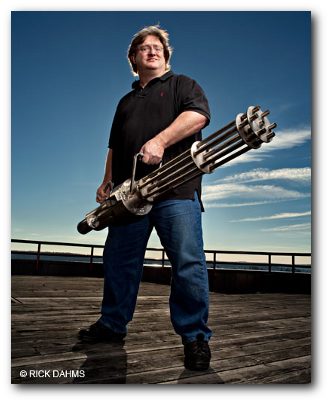Gabe Newell at Valve is infamous for replying to emails. Having previously featured articles on this blog from developers such as Mainly About Games, and NimbleBit on their ethos with user research in games, and the practicalities of implementing it, I thought I’d have nothing to lose from emailing Gabe for Valve’s unique perspective.

Remember to be polite....
***********************************************************
Hi Gabe
I write a blog about User Research in games, and know that play-testing, and incorporating player insight, is a huge deal at Valve.
I was wondering if you could give a couple of sentences on your own opinions as to why user research is an important part of the game development process, and how you do this at Valve.
While I’m making wishes, I’d also like a motorcycle, and a picture of you in a cowboy hat. If not, just the sentences will be great!
Thanks, and all the best
Steve Bromley
***********************************************************
And great news, I got a reply! Gabe forwarded my email to Mike Ambinder, an experimental psychologist at Valve. He described Valve’s philosophy around integrating user research in games as follows:
“At Valve, we see our game designs as hypotheses and our playtests as experiments to validate these hypotheses. In addition, we always want to iterate and improve on our work, and we are constantly seeking feedback – through playtests and other means – in order to do so. By making use of a wide array of user research techniques, we will make better decisions and as a consequence, better games.“
I followed up with Mike, to get a bit more information about the practical side of implementing user research and play-testing throughout the development process:
“We start playtesting as early as we can—as soon as we have something playable. We’ll start with internal folks and then bring in external folks soon after.
In terms of research techniques, we like to use the match the right methodology to the desired form of data. If surveys and interviews are most useful, we’ll do them. If it makes more sense to look at gameplay stats or physiological data, we’ll do them instead (or in addition). Our most common form of playtesting is direct observation followed by a brief survey and then Q&As. We don’t use biofeedback too much in our standard playtests, but we’re running a bunch of supplemental playtests on the side that concentrate on biofeedback data, and we hope to incorporate these methods into our practices going forward.“
Thanks Valve! Mike was able to give some really interesting direct insight into how they incorporate user testing into the development process. Still waiting for my cowboy hat pic though…
Thanks for this short n sweet article, Steve. Points I find of interest are that a) Valve integrate usability testing into the heart of their design practice and b) you don’t have to have all-singing-all-dancing biometric feedback to do usability testing as well as Valve. (Tho’ also noted they may go more in that direction in future.)